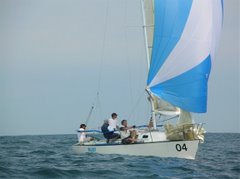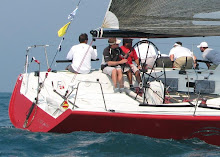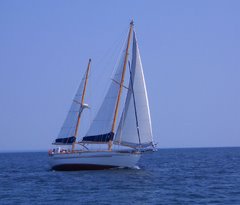I am just back from Charleston Race Week, where I sat in a RIB each day, watching, coaching and rescuing flip flops, hats and missed beer cans. It is always an interesting time when you are at a regatta and not sailing. Can’t say that I totally enjoy it but you always learn a lot by watching how others are doing things.
I was there supporting Brad and his Viper 640 team of Lee Shuckerow and Eric Vigrass. This is the second event that we at Doyle Boston Sailmakers have done in the Viper fleet and it certainly will not be the last. If you remember I sailed the St. Pete NOOD regatta on the Viper.
For this event we brought a new set of sails, version 2.0 if you will, that we finished just minutes before jumping in the van and heading south. The new sails are a tweak from the sails that I used in St. Pete, we felt that we were close to what we wanted but we knew we had lots of room for tweaking and that is what we did. The new sails are very nice and people on the race course really noticed that Brad was there. The boys ended up 3rd in the event, not to bad considering the boat they used is anywhere from 75-100 pounds heavier then the rest of them!
Anyway, I wanted to talk more about my observations from the ‘Coach boat’ then how the sails looked or how the team sailed. One thing that the Viper class does that I really like is the top to bottom flow of information between the best of the fleet to the new comers and folks back in the pack a ways. One of the reasons that I went down in the RIB was to help the fleet out with observations and give folks that were struggling some help to improve their position in the fleet and that in turn increases their FUN factor.
The fleet is very open to help and is often rather spongy in wanting more help and more info on how to get better and get up the fleet farther. The Viper fleet, lead by Class President Justin Scott try very hard to have a debrief at the end of the day where the top boats from the day talk about how they were set up, how they sailed the day and what they might have learned. All of this to immediately helps the fleet get better and have closer sailing. I truly wish that more fleets did this!
For this event we only were able to hold one such debrief, on Saturday night, but the information shared was helpful for the fleet and I noticed that many of the things that we talked that night suddenly appeared on more and more boats. This shows that these folks want to learn and want to get better. For the debrief Ethan Bixby and Ched Proctor from North Sails and myself answered many questions and gave tips of what we saw, how they sailed that day from Ethan and Ched’s perspective as they sailed. It is always interesting to see how other teams come to the same solution using a different path.
Some of the things that I noticed from the Coach Boat are as follows.
1) Not trimming the jib hard enough.
Many of top crew have the sail geometry/dynamics set up so that when they are fully sheeting in going upwind in most breeze the clew of the jib is either two blocked or very close.
2) Having the jib tack way up in the air
Setting up with the tack to high in the air changes a couple of important things. 1) It changes the whole geometry of the jib, sheeting and set up. 2) It opens the end plate effect up. You will find that if your tack is up much more then 2” you will be quickly running out of jib track and you will not be able to slide the lead back to open the leech and “out haul” the foot.
3) Not having the main halyard hoisted all the way
Again this changes the sheeting geometry of the sail. It makes your leech appear longer, which with the bridle will not allow you to trim your mainsheet hard enough. It also means that you will end up with big wrinkles in the luff of your sail as the Cunningham will bottom out.
4) Forgetting to pull the outhaul back on before heading upwind
In the big breeze on Friday and Sunday, I noticed many times that as boats rounded the leeward with their outhaul eased way out, they would not hold the lane with the boat that had the proper set up. The boat with the eased outhaul was always over powered, heeled too much and going a bit sideways. All bad when trying to hold that lane either in front or behind the boat around you.
5) Not sailing with enough Vang/GNAV in heavy air upwind.
What happens here is that when you ease the mainsheet in the big puffs your boom raises and actually powers the sail more! Not at all what you want when you are already over powered.
6) Not playing the jib sheet enough in big puffs
With most sport boats, you will find that as soon as the breeze is enough to start washing out/flogging the mainsail you need to start to ease the jib sheet as well. Otherwise the boat loses balance and the jib starts to pull the bow down away from the breeze. The good guys are adjusting the jib with each puff to keep the bow moving forward.
7) Sailing with the rig too loose in big breeze
Again this allows the sails to power back up and makes the boat heel more and go sideways.
8) Great big giant smiles on faces going downwind in 20 knots of breeze!
Only cure for this is to go back to sailing lead mines!
I would like to end this little blog session thanking the Viper fleet for welcoming us into the class with open arms, say thank you to the Charleston Circle 1 Race Committee for running an excellent regatta and thanking you all for paying to attention to this blog.
Cheers
Tac





